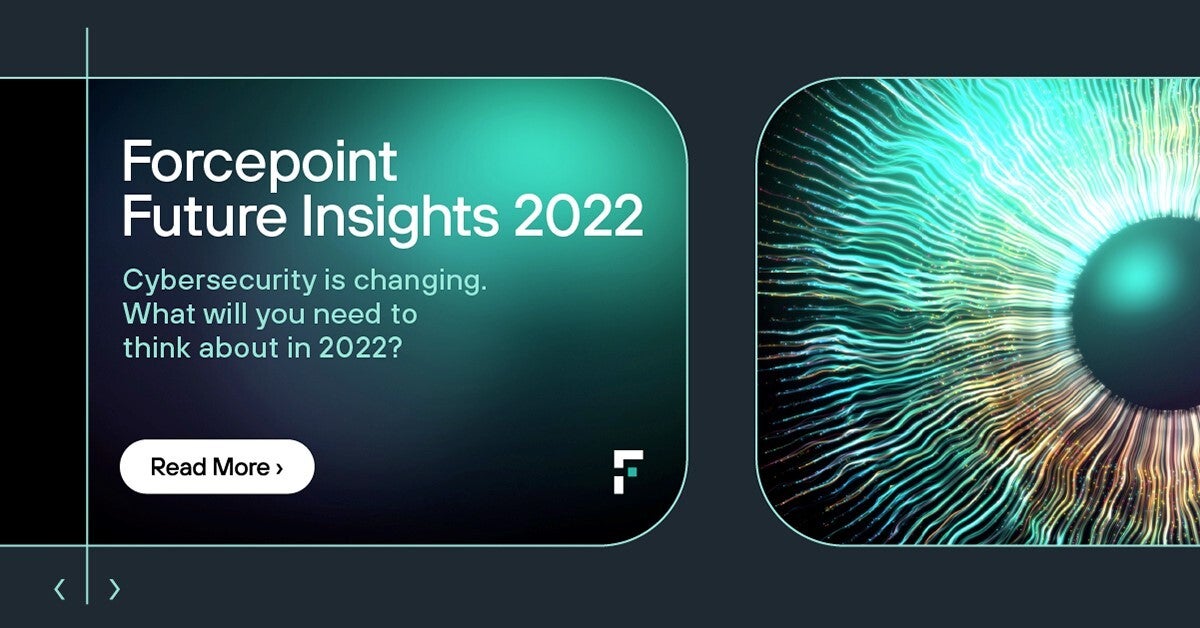Welcome to the fifth and final mail service from Forcepoint’southwardFuture Insights serial, which offers insights and predictions on cybersecurity that may go pressing concerns in 2022.

EBOOK
Future Insights 2022 eBook
Here is the side by side mail service from
Petko Stoyanov, Forcepoint’s Global Primary Technology Officer:
Ransomware has become the sleeper agent of cybersecurity. A sleeper agent is a spy that worms their mode into a country or organization and behaves unremarkably until they’re chosen upon to act out their mission months or years downward the road. In the case of ransomware, everyone thinks the oftentimes disastrous and harmful effects happen immediately. If I’k your colleague and electronic mail you a document, chances are yous’d open information technology. Once activated, the malware could overwhelm and compromise your organization in seconds, if that’s the intent. Merely non always.
More than often, the malicious ransomware lawmaking could incubate and stay hidden for months, only to be activated on a sure time, like a specific day, even timed to the stage of the moon. And over the grade of months, the malware can slowly spread, encrypting things—non all at in one case but niggling past niggling—taking things that were once good and exploiting them to practise bad things throughout the organization or ecosystem. Like I said, sleeper agent.
So how are we supposed to build resilient systems and proceed operating our businesses or governments in low-cal of the rising ransomware threat?
More detection is not the solution
Global enterprises and governments, both federal and local, accept invested billions in trying to detect and thwart
ransomware
. Detection is an of import part of a resilient infrastructure, just it could have vi to ix months for us to see data breaches come to light. Patently, more than detection is not the solution. As an industry, nosotros’ve failed at detection. We’ve tried to do information technology for decades. Every time we innovate, the bad guys find a style to circumvent it. In recent years we leaned into machine learning and AI-based malware detection tools. Innovations like AI are useful, just judge what, the bad guys are besides using AI and deep fakes. The innovation arms race hasn’t eliminated or reduced threats like ransomware. Instead, ransomware attacks keep to escalate in scope and financial touch.
In response, our industry has embraced Cypher Trust architectures and explicit-trust approaches, but most Cypher Trust journeys have focused largely on identity and admission. The contempo evolution in hybrid workforces and digital transformation, and their concomitant usage of content and electronic information everywhere, are leading indicators of where Zero Trust must become next: data.

Blog SERIES
Forcepoint Future Insights 2022
Shifting to 100% prevention
It’south no understatement that information is the primal nervous arrangement of an organization. Data is ubiquitous and practically standardized, from PDFs and electronic mail to web pages and databases. Companies must rethink their perimeter, because the perimeter is at present wherever data is used. Put some other way: if you focus on authentication and detection, you may exist successful at knowing who a person is on the network and what they’re allowed to admission. But you might not know what they’re accessing and why.
Analytics tools are incredibly useful for helping pinpoint moments of potential risk, just it’s still very much like looking for a needle in a haystack. If we follow Zero Trust, then let’s non trust any of the avails coming into the network in the first identify. In a model of 100% prevention, you decide that all content is bad and sanitize everything, regardless of source.

All or nada, or simply
nothing, is radical thinking, but existential threats like ransomware demand a fresh approach. Business and cybersecurity leaders must embrace Zero Trust content transformation technologies like content disarm and reconstruction (CDR) that have matured for the enterprise. CDR assumes all files coming into your network have malware. CDR intercepts a certificate at the network purlieus, re-creates the content from scratch, and delivers information technology clean and safe to the intended recipient. It won’t matter if a cyber thief hijacked a supplier partner email account to manipulate me (fatty risk) into clicking an infected attachment. The file will be clean before the e-mail even lands in my inbox. Threat prevented.
In these times, we demand unconventional approaches to defend our economies, our disquisitional infrastructure, and our way of life. When cybersecurity tin enable business organisation-as-usual, then we will encounter more opportunities for the manufacture. The hyperscaling of Information technology resource required to friction match today’s hybrid workforce demands calls for an equal scaling of cybersecurity capabilities. Whereas they were willing previously to implement racks of bespeak products, more than and more than customers are asking for integrated deject deployment models. They volition want to brand cybersecurity as unproblematic as a service, like flipping a switch to deploy threat removal, data security, firewall, spider web security and other capabilities wherever they demand it and whenever they want.
As enterprise and government agency leaders continue maturing their digital transformation efforts, they’re recognizing the business enabler that is cybersecurity. The Nix Trust journey will proceed as organizations look to proactively forbid compromise and stop trying to detect or react to threats. This makes me optimistic about the side by side year and the years after that.
Future Insights Takeaways:
-
100% prevention becomes the standard as organizations will fully embrace Zero Trust principles. Cyber teams will assume everything is bad, sanitize it all, and ensure least privileged admission.
-
Convergence and hyperscaling of capabilities will be the norm as we’ll see simplicity enabled past maturation of SASE and cloud security as-a-service..
-
Threat removal tin calibration for enterprises and governments: no longer a niche use case, the combination of CDR, SWG, and RBI engineering science working together will give an arrangement more than a fighting gamble against ransomware attacks.
Source: https://www.forcepoint.com/blog/x-labs/future-insights-age-of-prevention
 RosyandBo.com Trusted Information and Education News Media
RosyandBo.com Trusted Information and Education News Media




